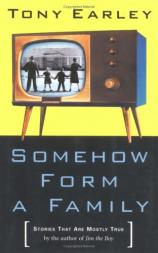Somehow Form a Family: Stories That Are Mostly True
Review
Somehow Form a Family: Stories That Are Mostly True
There are two acts that require a lot of intestinal fortitude. One is to kick over the rocks in the family garden, take notes on what crawls out from underneath, and share what you've observed with the world in the form of words on paper. The other is to deviate from a tried-and-true formula. Tony Earley does both with his new book, SOMEHOW FORM A FAMILY, but demonstrates much more than courage in doing so. In fact, if the test of good literature is the degree of its truth-telling, Earley may well be the best of our best.
Earley, coming off of the success of JIM THE BOY, could have played it safe by writing and publishing another novel. Not that it wouldn't have been anything less than excellent; I don't think that the man is capable of writing a mediocre sentence. Earley, however, with SOMEHOW FORM A FAMILY, has thrown his readership a change-up with a collection of what he chooses, quite properly, to call personal essays. These essays deal with Earley's childhood, young adulthood, and family. He doesn't flinch from matters embarrassing or uncomfortable or unpleasant. He doesn't rub your nose in it, either. Earley just lays it out, with prose that is so beautiful that you'll spend half of your time underlying or copying phrases that he drops every page or so. I would unequivocally bet the farm and all that is on it that any one of these essays will be among the best reading you do this year.
There is, quite simply, no way to pick a favorite among the 10 stories that comprise this volume. There's good reason for this. Earley focuses on a different bit of common ground in each story, and in the course of doing so, accomplishes the magnificent task of giving his readers everything they need to know within a relatively short span of pages. Take "Somehow Form A Family," the title story. Earley discusses his life from the time that he was roughly 10 years of age to his young adulthood in the course of 18 pages and, in lean, straightforward prose with a brevity of word and an abundance of metaphor, tells us everything we need to know not only about his own life but also the lives of his family and his neighbors. "The Courting Garden" begins, beautifully, with Earley's wife Sarah, during their engagement, suggesting that they plant a garden together. The way in which they resolve their difference over "square vs. row" planting, and, more importantly, Earley's account of it, is worth committing to memory in both form and substance. Then there is "Ghost Stories," an account of ghost hunting in New Orleans that captures the other spirits of that city as well, in a way that no other writer has ever quite managed. Ironically, I was in New Orleans the day after I finished SOMEHOW FORM A FAMILY and could not get "Ghost Stories" out of my mind. There is also "The Quare Gene," an account of various terms that were in common use in Earley's household as he was growing up. It is an essay not to be missed by anyone who loves language, its origins, and its passings.
Earley teaches creative writing at Vanderbilt University. If he is able to transmute to his students even a quarter of the literary ability that he demonstrates in SOMEHOW FORM A FAMILY, the reading world has much to look forward to. For now, we can look forward to much, much more from Earley.
Reviewed by Joe Hartlaub on May 1, 2001
Somehow Form a Family: Stories That Are Mostly True
- Publication Date: May 1, 2001
- Genres: Nonfiction
- Hardcover: 192 pages
- Publisher: Algonquin Books
- ISBN-10: 1565123026
- ISBN-13: 9781565123021




